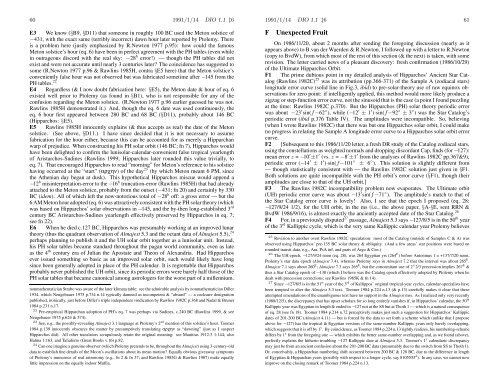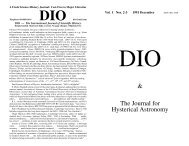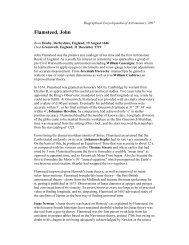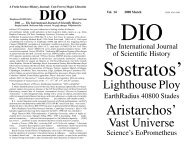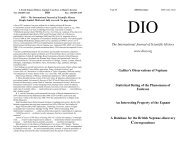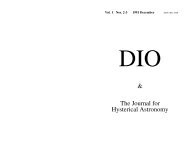DIO 1.1 - DIO, The International Journal of Scientific History
DIO 1.1 - DIO, The International Journal of Scientific History
DIO 1.1 - DIO, The International Journal of Scientific History
Create successful ePaper yourself
Turn your PDF publications into a flip-book with our unique Google optimized e-Paper software.
60 1991/1/14 <strong>DIO</strong> <strong>1.1</strong> ‡6<br />
E3 We know (§B9, §D11) that someone in roughly 100 BC used the Meton solstice <strong>of</strong><br />
−431, with the exact same (terribly incorrect) dawn hour later reported by Ptolemy. <strong>The</strong>re<br />
is a problem here (justly emphasized by R.Newton 1977 p.95): how could the famous<br />
Meton solstice’s hour (eq. 6) have been in perfect agreement with the PH tables (even while<br />
in outrageous discord with the real sky: −28 h error!) — though the PH tables did not<br />
exist and were not accurate until nearly 3 centuries later? <strong>The</strong> coincidence has suggested to<br />
some (R.Newton 1977 p.96 & Rawlins 1985H, contra §E5 here) that the Meton solstice’s<br />
conveniently false hour was not observed but was fabricated sometime after −145 from the<br />
PH tables. 22<br />
E4 Regardless (& I now doubt fabrication here: §E5), the Meton date & hour <strong>of</strong> eq. 6<br />
existed well prior to Ptolemy (as found in §B1), who is not responsible for any <strong>of</strong> the<br />
confusion regarding the Meton solstice. (R.Newton 1977 p.96 earlier guessed he was not.<br />
Rawlins 1985H demonstrated it.) And, though the eq. 6 date was used continuously, the<br />
eq. 6 hour first appeared between 280 BC and 68 BC (§D11), probably about 146 BC<br />
(Hipparchos: §E5).<br />
E5 Rawlins 1985H innocently explains (& thus accepts as real) the date <strong>of</strong> the Meton<br />
solstice. (See above, §D11.) I have since decided that it is not necessary to assume<br />
fabrication for the hour either, because this can be accounted for as merely a Hipparchan<br />
warp <strong>of</strong> prejudice. When constructing his PH solar orbit (146 BC; fn 7), Hipparchos would<br />
have been delighted to confirm the lunisolar-calendar-convenient false tropical yearlength<br />
<strong>of</strong> Aristarchos-Sudines (Rawlins 1999; Hipparchos later rounded this value trivially, to<br />
eq. 7). That encouraged Hipparchos to read “morning” for Meton’s reference to his solstice<br />
having occurred at the “start” (αρχην) <strong>of</strong> the day 23 (by which Meton meant 6 PM, since<br />
the Athenian day began at dusk). This hypothetical Hipparchos miscue would append a<br />
−12 h misinterpretation-error to the −16 h truncation-error (Rawlins 1985H) that had already<br />
attached to the Meton solstice, probably from the outset (−431; fn 20) and certainly by 330<br />
BC (idem). All <strong>of</strong> which left the now-notorious total <strong>of</strong> −28 h <strong>of</strong>f: a gross error — but the<br />
6 AM Meton hour adopted (eq. 6) was attractively consistent with the PH solar theory (which<br />
was based on Hipparchos’ solar observations in −145, and the by-then long-established 3 rd<br />
century BC Aristarchos-Sudines yearlength effectively preserved by Hipparchos in eq. 7;<br />
see fn 22).<br />
E6 When he died c.127 BC, Hipparchos was presumably working at an improved lunar<br />
theory (thus the quadrant observation <strong>of</strong> Almajest 5.3 and the octant data <strong>of</strong> Almajest 5.5), 24<br />
perhaps planning to publish it and the UH solar orbit together as a lunisolar unit. Instead,<br />
his PH solar tables became standard throughout the pagan world community, even as late<br />
as the 4 th century era <strong>of</strong> Julian the Apostate and <strong>The</strong>on <strong>of</strong> Alexandria. Had Hipparchos<br />
ever issued something so basic as an improved solar orbit, such would likely have long<br />
since been generally adopted in place <strong>of</strong> the PH calendar. It is regrettable that Hipparchos<br />
probably never published the UH orbit, since its periodic errors were barely half those <strong>of</strong> the<br />
PH solar tables that became canonical among astrologers for the worst part <strong>of</strong> a millennium.<br />
nonmathematician Strabo was aware <strong>of</strong> the later klimata table: see the admirable analysis by nonmathematician Diller<br />
1934, which Neugebauer 1975 p.734 n.14 typically damned as incompetent & “absurd” — a cocksure denigration<br />
published, ironically, just before Diller’s triple independent vindication by Rawlins 1982C p.368 and Nadal & Brunet<br />
1984 p.231 n.17.<br />
22 Pre-empirical Hipparchan adoption <strong>of</strong> PH’s eq. 7 was perhaps via Sudines, c.240 BC (Rawlins 1999, & see<br />
Neugebauer 1975 p.624 & 574).<br />
23 See, e.g., the possibly-revealing Almajest 3.1 language at Ptolemy’s 2 nd mention <strong>of</strong> this solstice’s hour. Toomer<br />
1984 p.139 innocently obscures the matter by presumptively translating αρχην as “dawning” (just as I suspect<br />
Hipparchos did). All other translators scrupulously retain the original meaning: see Manitius 1912-3 1:144; also<br />
Halma 1:163, and Taliaferro (Great Books v.16) p.82.<br />
24 Can one imagine a genuine observer (which Ptolemy pretends to be, throughout the Almajest) using 3-century-old<br />
data to establish fine details <strong>of</strong> the Moon’s oscillations about its mean motion? Equally obvious giveaway symptoms<br />
<strong>of</strong> Ptolemy’s innocence <strong>of</strong> real astronomy (e.g., fn 2 & fn 37; and Rawlins 1985G & Rawlins 1987) make equally<br />
little impression on the equally indoor Muffia.<br />
1991/1/14 <strong>DIO</strong> <strong>1.1</strong> ‡6 61<br />
F<br />
Unexpected Fruit<br />
On 1986/11/20, about 2 months after sending the foregoing discussion (nearly as it<br />
appears above) to B.van der Waerden & R.Newton, I followed up with a letter to R.Newton<br />
(copy to BvdW), from which most <strong>of</strong> the rest <strong>of</strong> this section (& the next) is taken, with some<br />
revision. <strong>The</strong> letter carried news <strong>of</strong> a pleasant discovery: fresh confirmation (1986/10/29)<br />
<strong>of</strong> the Ultimate Hipparchos Orbit.<br />
F1 <strong>The</strong> prime dubious point in my detailed analysis <strong>of</strong> Hipparchos’ Ancient Star Catalog<br />
(Rawlins 1982C) 25 was its attribution (pp.366-371) <strong>of</strong> the Sample A (zodiacal stars)<br />
longitude error curve (solid line in Fig.3, ibid) to pre-solar-theory use <strong>of</strong> raw equinox observations<br />
for zero point: if intelligently applied, this method would more likely produce a<br />
zigzag or step-function error curve, not the sinusoid that is the case (a point I found puzzling<br />
at the time: Rawlins 1982C p.370). But the Hipparchos (PH) solar theory periodic error<br />
was about −23 ′ sin(f−62 ◦ ), while (−12 ′ ± 1 ′ )·sin(f−92 ◦ ± 3 ◦ ) was the Star Catalog’s<br />
periodic error (ibid p.376 Table IV). <strong>The</strong> amplitudes were incompatible. So, believing<br />
(when I wrote Rawlins 1982C) that there was but one Hipparchos solar orbit, I could make<br />
no progress in relating the Sample A longitude error curve to a Hipparchos solar orbit error<br />
curve.<br />
F2 [Subsequent to this 1986/11/20 letter, a fresh DR study <strong>of</strong> the Catalog zodiacal stars,<br />
using the constellations as weighted normals and dropping discordant Cap, finds (for −127):<br />
mean error z = −10 ′ ±1 ′ (vs. z = −8 ′ ±1 ′ from the analyses <strong>of</strong> Rawlins 1982C pp.367&9),<br />
periodic error (−14 ′ ± 1 ′ )·sin(f−101 ◦ ± 6 ◦ ). This solution is slightly different from<br />
— though statistically consistent with — the Rawlins 1982C solution just given in §F1.<br />
Both solutions are quite incompatible with the PH orbit’s error curve (§F1), though their<br />
amplitudes are close to that <strong>of</strong> the UH orbit.]<br />
F3 <strong>The</strong> Rawlins 1982C incompatibility problem now evaporates. <strong>The</strong> Ultimate orbit<br />
(UH) periodic error curve was about −13 ′ sin(f−71 ◦ ). <strong>The</strong> amplitude’s match to that <strong>of</strong><br />
the Star Catalog error curve is lovely! Also, I see that the epoch I proposed (eq. 28:<br />
−127/9/24 1/2), for the UH orbit, in the ms (i.e., the above paper, §A-§E, sent RRN &<br />
BvdW 1986/9/16), is almost exactly the anciently accepted date <strong>of</strong> the Star Catalog. 26<br />
F4 For, in a previously disputed 27 passage, Almajest 5.3 says −127/8/5 is in the 50 th year<br />
<strong>of</strong> the 3 rd Kallippic cycle, which is the very same Kallippic calendar year Ptolemy believes<br />
25 Revision to another overt Rawlins 1982C speculation: most <strong>of</strong> the Catalog (outside <strong>of</strong> Samples C & A) was<br />
observed using Hipparchos’ pre-135 BC solar theory & obliquity. (And a few areas’ star positions were based on<br />
rounded transit data, e.g., Ara, PsA inf, and parts <strong>of</strong> Argo & Cen.)<br />
26 <strong>The</strong> UH epoch, −127/9/24 noon (eq. 28), was 264 Egyptian yrs (264 E ) before Antoninus 1 = +137/7/20 noon,<br />
Ptolemy’s star data epoch (Almajest 7.4), whereas Ptolemy says in Almajest 7.2 that the interval was about 265 E .<br />
Almajest 7.1 says about 260 E ; Almajest 7.3 says 265 E , but the concomitant use <strong>of</strong> 2 ◦ 2/3 precession implies 267 E &<br />
thus a Star Catalog epoch <strong>of</strong> −130 (which I believe was the Catalog epoch effectively adopted by Ptolemy when he<br />
dealt with precession corrections; see Rawlins 1985K & fn 14).<br />
27 Since −127/8/5 is in the 51 st year <strong>of</strong> the 3 rd <strong>of</strong> Kallippos’ original tropical-year cycles, calendar-specialists have<br />
been tempted to alter the Almajest 5.3 text. Toomer 1984 p.224 n.13 (& p.13) carefully makes it clear that these<br />
attempted emendations <strong>of</strong> the unambiguous text have no support in the Almajest mss. As I realized only very recently<br />
(1988/12/5), the discrepancy that has upset scholars for so long entirely vanishes if, in Hipparchos’ calendar, the 50 th<br />
Kallippic year was Egyptian in length & ended in −127 not at the SS but at Thoth 1 — which is a natural consequence<br />
<strong>of</strong> eq. 28 (see fn 18). Toomer 1984 p.214 n.72 perceptively makes just such a suggestion for Hipparchos’ Kallippic<br />
dates <strong>of</strong> 201-200 BC (Almajest 4.11) — but is forced by the data to set forth a scheme which (unlike that I propose<br />
above for −127) has the tropical & Egyptian versions <strong>of</strong> the same-number Kallippic years only barely overlapping,<br />
which suggests that it is <strong>of</strong>f by 1 y . By coincidence, as Toomer 1984 p.224 n.13 rightly realizes, his numbering-scheme<br />
differs by 1 y from the foregoing one — which exhibits far better same-number overlapping and, as we found (above),<br />
perfectly explains the hitherto-troubling −127 Kallippic date at Almajest 5.3. Toomer’s 1 y calendaric discrepancy<br />
may just be from an ancient confusion about the 201-200 BC data (presumably due to the switch from SS to Thoth 1).<br />
Or, conceivably, a Hipparchan numbering shift occurred between 200 BC & 128 BC, due to the difference in length<br />
<strong>of</strong> Egyptian & Hipparchan years (possibly with respect to a longer cycle, say 8105555 d ). In any case, we cannot now<br />
improve on the closing remark <strong>of</strong> Toomer 1984 p.224 n.13.


